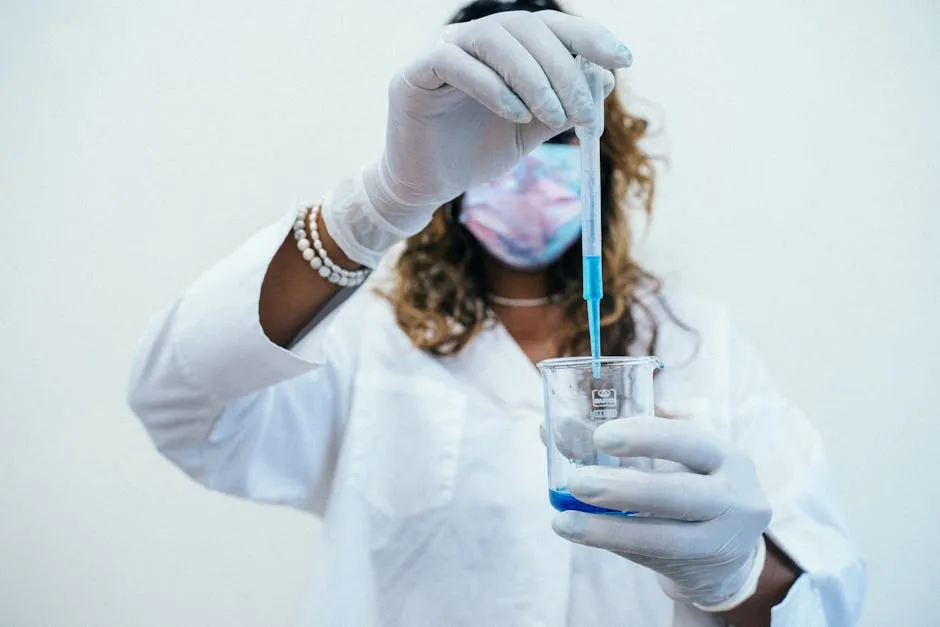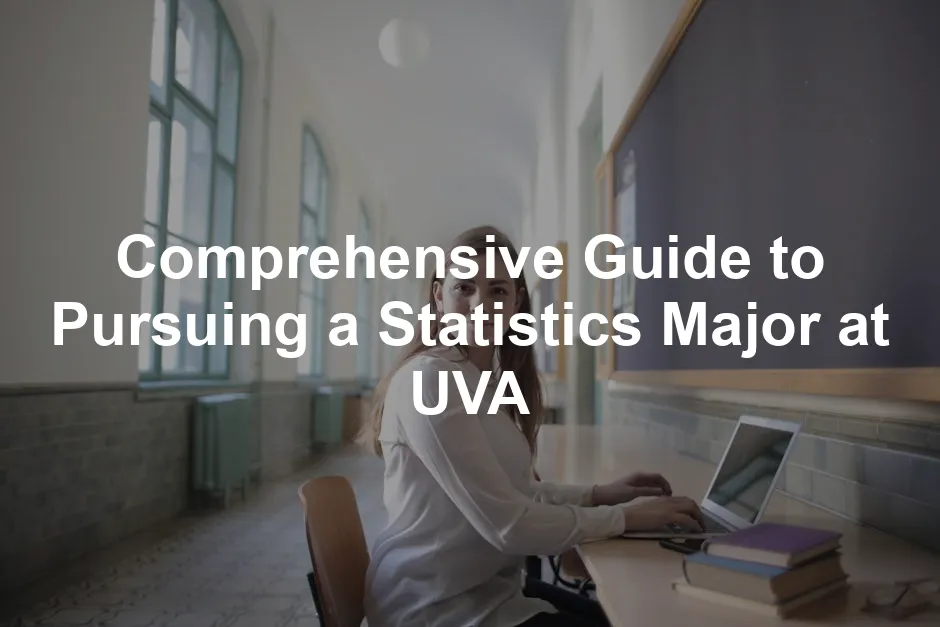Introduction
The University of Virginia (UVA) stands tall in the academic world. Founded in 1819 by Thomas Jefferson, UVA has a rich history and a commitment to excellence. Known for its rigorous academic programs, beautiful campus, and vibrant culture, UVA attracts students from all walks of life. Among its many offerings, the Statistics major shines brightly, particularly in today’s data-driven society.
In our modern era, statistics is not just for math enthusiasts. It’s vital across various fields like business, healthcare, and technology. A statistics major equips students with essential skills to analyze data and make informed decisions. Whether you’re deciphering trends in finance or unraveling mysteries in healthcare, a statistics degree is your key to a world of opportunities.
At UVA, students can choose between two undergraduate paths: the Bachelor of Arts (B.A.) in Applied Statistics and the Bachelor of Science (B.S.) in Statistics. Each program offers unique advantages, allowing students to tailor their education to their interests and career goals. So, whether you’re leaning towards a more practical application of statistics or a solid theoretical foundation, UVA has you covered. Let’s dig deeper into what makes the Statistics program at UVA a compelling choice for aspiring data enthusiasts.

Understanding the Statistics Major at UVA
Overview of the Statistics Department
Established in 1989, the Statistics Department at UVA has grown tremendously. Originally a small unit, it’s now a dynamic hub of research and education. The department boasts a faculty of 19 dedicated members who are recognized for their expertise and contributions to the field. With a focus on interdisciplinary research, faculty members collaborate with various departments, including biostatistics in the School of Medicine.
The department is consistently ranked among the best, currently holding a prestigious spot within the top 15 statistics programs nationwide. This recognition reflects its commitment to providing a high-quality education. Students benefit from a curriculum that balances theory and application, preparing them for real-world challenges.
Diversity is a cornerstone of the department’s philosophy. The Statistics program attracts students from diverse backgrounds, enriching the learning environment. This blend of ideas and perspectives encourages innovative thinking and collaboration. With a vibrant mix of students, the Statistics Department at UVA is a welcoming space for anyone passionate about data analysis and interpretation.

Degree Options: B.A. vs. B.S.
B.A. in Applied Statistics
The B.A. in Applied Statistics focuses on practical applications. It prepares students to design experiments, analyze data, and communicate results effectively. This program is ideal for those interested in real-world applications of statistics. Students can choose from three concentrations: Finance and Business, Biostatistics, and Data Science.
The program requires six core courses, including “Data to Knowledge,” “Foundations of Statistics,” and “Introduction to Regression Analysis.” Students must also complete four restricted elective courses, ensuring they gain hands-on experience in data analysis. Speaking of hands-on experience, consider enhancing your statistical toolkit with R for Data Science. This book is an essential guide for anyone looking to import, tidy, transform, visualize, and model data effectively.
B.S. in Statistics
The B.S. in Statistics offers a more theoretical approach, diving deeper into the mathematical foundations of statistics. This program consists of ten core courses, including “Mathematical Statistics,” “Probability,” and “Linear Models.” Students must complete five restricted elective courses, with an emphasis on data analysis and computational techniques.
Both degrees provide comprehensive training, but the B.A. is more application-focused, while the B.S. leans towards theoretical foundations. Choosing between them depends on your career aspirations and interests in the field of statistics. If you’re looking to deepen your understanding of statistical principles, I highly recommend The Art of Statistics: Learning from Data by David Spiegelhalter. This book is a fantastic resource for understanding how to think statistically in today’s data-driven world.
With these options, students at UVA can shape their educational journey to align with their future goals. Whether you envision a career in data science, finance, or healthcare, the statistics programs at UVA offer the tools you need to succeed in a variety of industries.

B.S. in Statistics
The Bachelor of Science (B.S.) in Statistics at UVA focuses on the theoretical foundations of statistics, equipping students with a robust understanding of both statistical theory and practical applications. This program is perfect for those who enjoy the nitty-gritty details of data analysis and want to master the mathematical intricacies behind statistical methods.
Students will dive into a comprehensive curriculum that emphasizes mathematical rigor. The B.S. requires ten core courses, ensuring that graduates possess a solid grasp of foundational concepts. Core classes include “Probability,” “Mathematical Statistics,” and “Data to Knowledge.” These courses prepare students to tackle complex statistical problems, making them valuable assets in the job market. To complement your studies, consider getting Python for Data Analysis. This book is a must-have for mastering data wrangling with Pandas, NumPy, and IPython.
In addition to core courses, students must select five restricted electives. These electives allow students to tailor their education to their interests, whether they lean toward data science, biostatistics, or financial analytics. The structure ensures a well-rounded education while also allowing for specialization.
When comparing the B.A. and B.S. degrees, the B.A. in Applied Statistics offers a more application-oriented approach, focusing on real-world scenarios. In contrast, the B.S. dives deep into the theoretical aspects of statistics. While both degrees prepare students for careers in data analysis, the B.S. is particularly suited for those aspiring to pursue graduate studies in statistics or related fields.

Program Requirements and Prerequisites
To declare a major in statistics, students must complete specific prerequisite courses for both the B.A. and B.S. programs. For the B.S. in Statistics, the prerequisites include Calculus II, Introductory Statistics, Introductory Programming, and two essential statistics courses: “Probability” and “Introduction to Regression Analysis.” Completing these courses ensures that students are adequately prepared for the rigors of the program.
The core courses required for the B.S. program encompass ten key subjects. These include foundational topics like “Mathematical Statistics” and “Data to Knowledge.” Additionally, students must take courses such as “Statistical Models” and “Experimental Design.” The B.A. program has a slightly different core, focusing more on practical applications, but both paths require a capstone project to integrate and apply learned concepts.
Electives play a critical role in both programs. For the B.S., students must complete five restricted electives, ensuring at least three come from the Data Analysis list. This allows students to explore advanced topics like “Statistical Machine Learning,” “Multivariate Statistics,” and “Applied Analytics for Business.” Restrictions prevent redundancy, as only one course from overlapping categories, such as different machine learning courses, can fulfill major requirements. This thoughtful structure encourages students to diversify their learning while maintaining focus on critical areas in statistics.

Capstone Project
A highlight of both the B.A. and B.S. programs is the capstone project. This requirement involves teamwork, where groups of three to four students collaborate on an extensive data analysis project. The capstone is designed to synthesize the knowledge and skills acquired throughout the program.
Students begin by identifying questions of interest, preparing the necessary data, and selecting appropriate statistical analyses. This hands-on approach not only reinforces theoretical concepts but also hones practical skills in data interpretation and presentation. The project culminates in a final report and a formal presentation, allowing students to showcase their findings and analytical prowess.
Collaboration is key during the capstone experience. Working in teams fosters communication skills and exposes students to diverse viewpoints within statistical analysis. Guidance from faculty throughout the project ensures that students remain on track and receive constructive feedback. This collaborative effort not only enhances learning but also mimics real-world scenarios, preparing students for future professional teamwork.
Overall, the capstone project is an invaluable component of the statistics curriculum, providing students with practical experience that is highly regarded by employers in various industries. To further enhance your analytical skills, consider grabbing a copy of Practical Statistics for Data Scientists: 50 Essential Concepts. This book covers the must-know concepts that every data scientist should grasp.

Student Experience at UVA
Academic Life
At the University of Virginia, academic life is vibrant and engaging for statistics majors. The Statistics Department prides itself on offering a supportive environment that encourages students to thrive. Faculty members are approachable and passionate about teaching. They believe in fostering a nurturing atmosphere where students can explore their interests.
The department provides various resources to enhance learning. Students have access to tutoring services, ensuring no one feels lost in the numerical jungle. These sessions are often led by upperclassmen who excelled in their courses. Peer support can make a significant difference, especially during those late-night study sessions. And to keep your mind sharp during these sessions, a Graphing Calculator can be your best friend!
Labs play a crucial role in the academic experience. Equipped with cutting-edge technology, they allow students to apply theoretical knowledge practically. Here, students can experiment with real data sets and conduct hands-on analysis. This approach solidifies their understanding of complex statistical concepts.
Research opportunities abound, too. The department encourages undergraduates to engage in research projects alongside faculty members. This collaboration often results in published papers, giving students a competitive edge when applying for internships or graduate school. Additionally, students may also participate in ongoing departmental research, which often spans various fields like healthcare, economics, and social sciences.
The academic calendar is packed with workshops and guest lectures from industry professionals. These events not only provide networking opportunities but also give students insights into current trends in statistics. This exposure helps them stay ahead in the ever-evolving data landscape.
In summary, UVA offers a rich academic life for statistics majors. With robust support systems, hands-on labs, and research opportunities, students are well-prepared for their careers. The commitment to student success is evident, making the academic experience at UVA truly exceptional.

Extracurricular Activities
Extracurricular activities at UVA are as dynamic as the academic offerings. Statistics majors can join various clubs and organizations that align with their interests. The Statistics Club is particularly popular among students. It provides a platform for networking, skill development, and fun activities that foster a sense of community.
In addition to social gatherings, the club organizes guest speaker events. These sessions feature professionals in the field who share their insights and experiences. Students leave inspired and informed about potential career paths. Moreover, club members often collaborate on projects, allowing them to apply their statistical knowledge in real-world settings. And to make those study sessions more enjoyable, consider a Bluetooth Speaker for some background tunes!
Another fantastic opportunity lies within the Data Science Society. This group is perfect for students who want to delve into data analytics and machine learning. Through workshops and hackathons, students can sharpen their skills and collaborate with peers on innovative projects. These experiences are invaluable in today’s data-driven job market.
For those who enjoy giving back, community service initiatives are plentiful. Students can volunteer to assist local non-profits with data analysis. This engagement not only benefits the community but also allows students to apply their skills in meaningful ways. It’s a win-win situation, where learning meets social responsibility.
Research opportunities also extend beyond the classroom. Many students engage in summer internships with organizations that focus on data analytics. These positions often lead to full-time job offers after graduation. The Statistics Department actively supports students in securing internships, providing guidance and resources throughout the process.
In short, UVA offers a wealth of extracurricular activities for statistics majors. With clubs, community service, and internship opportunities, students can enhance their educational experience while making lasting connections.

Internships and Real-World Experience
Internships are crucial for statistics majors at UVA. They provide real-world experience that enhances classroom learning. The Statistics Department emphasizes the importance of internships, encouraging students to seek opportunities in various industries.
Students have interned with a variety of notable organizations. For instance, many have secured positions at tech companies, financial institutions, and healthcare organizations. These internships allow students to apply their statistical skills to practical challenges, bridging the gap between theory and practice.
One compelling example is an internship with a leading healthcare analytics firm. Students worked on projects involving patient data analysis, contributing to improved healthcare outcomes. This experience not only honed their technical skills but also provided insights into the impact of statistics on real-world decisions. If you’re looking to dive deeper into data science, check out Data Science from Scratch: First Principles with Python. It’s a great resource for understanding the fundamentals of data science.
Additionally, students often intern with governmental agencies. These roles typically involve data analysis that informs public policy. Working in such environments exposes students to the complexities of data interpretation and the ethical considerations involved.
The department plays a proactive role in helping students secure internships. Faculty members have strong ties with industry professionals, facilitating connections for students. They provide resources like resume workshops and interview preparation sessions to ensure students are competitive candidates.
Finally, the emphasis on networking is crucial. Statistics majors are encouraged to attend industry conferences and events. These gatherings allow students to meet potential employers and learn about emerging trends in the field.
In summary, internships are a vital part of the statistics major experience at UVA. With diverse opportunities, strong departmental support, and valuable networking, students are well-prepared for successful careers in various sectors.

Conclusion
Pursuing a statistics major at UVA offers numerous benefits. The academic environment is rich with support, resources, and opportunities for growth. Students enjoy a vibrant extracurricular scene, which fosters community and networking. Internships provide essential real-world experience, laying the groundwork for future careers.
Prospective students should explore their options and get involved. With so many resources at their fingertips, they can cultivate their passion for statistics. The department is committed to preparing students for successful careers in various fields, ensuring they are equipped to meet the demands of a data-driven world.
In short, choosing the statistics major at UVA is a wise decision. With a strong academic foundation and ample opportunities for practical experience, graduates leave ready to tackle the complexities of the modern workforce. The journey starts here—embrace the adventure! And while you’re at it, don’t forget to grab a pair of noise-canceling headphones for those study sessions!

FAQs
What are the differences between the B.A. and B.S. in Statistics?
The B.A. and B.S. in Statistics at UVA cater to different interests. The B.A. in Applied Statistics emphasizes practical applications. Students focus on designing experiments and analyzing data in real-world contexts. It includes three concentrations: Finance and Business, Biostatistics, and Data Science. Conversely, the B.S. in Statistics dives deeper into theoretical foundations. Students engage with advanced mathematical concepts, preparing for graduate studies. Both programs require core courses, but the B.S. includes more rigorous mathematical training. Ultimately, your choice depends on whether you prefer hands-on application or theoretical exploration.
What kind of jobs can I get with a statistics degree?
A statistics degree opens the door to an array of career opportunities. Graduates often find roles as data analysts, statisticians, and research scientists. Industries such as healthcare, finance, and technology value their analytical skills. For instance, data analysts help businesses make data-driven decisions. Statisticians design surveys and experiments to gather insights. Many graduates also pursue graduate degrees, enhancing their prospects in academia or specialized fields like biostatistics or data science. The versatility of a statistics degree is one of its greatest strengths.
Are there opportunities for research in the statistics program?
Absolutely! Research is a significant component of the statistics program at UVA. Students are encouraged to collaborate with faculty on various projects. These partnerships often lead to published papers and presentations at conferences. Undergraduates can engage in research opportunities that span diverse fields, from healthcare analytics to social sciences. By participating in research, students gain hands-on experience and deepen their understanding of statistical methods. This involvement also enhances their resumes, making them more competitive in the job market.
What resources are available for students struggling with coursework?
UVA offers a wealth of resources to support students facing challenges in their coursework. The Statistics Department provides tutoring services, often led by upperclassmen. These sessions are invaluable for grasping complex concepts or preparing for exams. Additionally, students can access academic advising and study groups. Many find that collaborative learning helps solidify their understanding. The department also hosts workshops focusing on specific skills or software tools, further aiding students in overcoming academic hurdles.
How can I network with alumni and professionals in the field?
Networking is vital for career success, and UVA facilitates this for statistics majors. The Statistics Club hosts events where students can meet alumni working in various industries. These gatherings allow students to gain insights into potential career paths and job opportunities. Moreover, students are encouraged to attend conferences and workshops. These events often feature industry professionals, providing an excellent platform for connections. Social media platforms like LinkedIn can also help students reach out to alumni and professionals, expanding their network beyond campus. Engaging in these activities is a smart way to build relationships and enhance career prospects.
The Statistics Department at UVA is recognized for its excellence. You can learn more about its offerings in this stanford statistics department guide.
Please let us know what you think about our content by leaving a comment down below!
Thank you for reading till here 🙂
All images from Pexels




